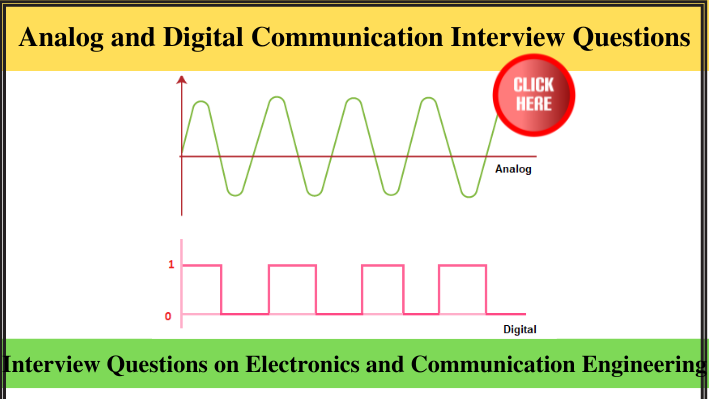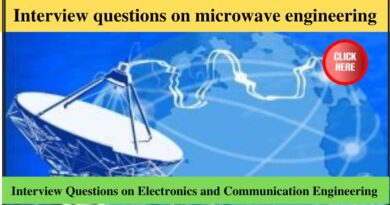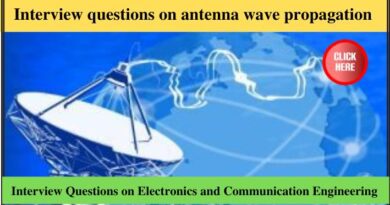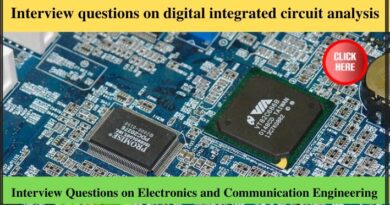Analog and Digital Communication Interview Questions
Analog and Digital Communication Interview Questions
Hello, In this blog. We will discuss Analog and Digital Communication Interview Questions. These questions are asked in many technical Interviews, Feel free to ask doubts and suggestions on it.
Also Read: Interview Questions on Signals and Systems
Interview questions on network analysis
Interview questions on Electronic circuit analysis
Interview Questions on Digital Electronics
Interview Questions on Electronic Devices and circuits
The Blog contains both analog communication and digital communication interview questions
Analog Communication Interview Questions:
What is analog communication and how does it differ from digital communication?
Analog communication is a method of transmitting continuous signals such as sound, video, and other data in an analog form, while digital communication involves transmitting discrete digital signals, typically represented as binary data.
What are the main types of analog communication?
The main types of analog communication are amplitude modulation (AM), frequency modulation (FM), and phase modulation (PM).
How does amplitude modulation (AM) work?
In amplitude modulation, the amplitude of a carrier wave is varied in proportion to the amplitude of the input signal.
How does frequency modulation (FM) work?
In frequency modulation, the frequency of a carrier wave is varied in proportion to the amplitude of the input signal.
Can analog signals be transmitted over long distances? Why or why not?
Yes, analog signals can be transmitted over long distances. However, they are more susceptible to noise and degradation, which can result in a loss of signal quality.
Digital Communication Interview Questions:
What is digital communication?
Digital communication is the transfer of data, voice, and video in digital form over communication channels.
What are the benefits of digital communication over analog communication?
The benefits of digital communication over analog communication include increased accuracy, noise immunity, better signal quality, and higher bandwidth efficiency.
What is error correction and how does it work in digital communication?
Error correction is a technique used in digital communication to detect and correct errors that occur during data transmission. It works by adding redundant data to the original message, allowing the receiver to detect and correct errors.
What is digital signal processing (DSP)?
Digital signal processing (DSP) is a field of electrical engineering that deals with the processing of signals in a digital form, typically through mathematical algorithms.
What is the difference between baseband and broadband signals in digital communication?
A baseband signal is a signal that occupies a limited bandwidth, while a broadband signal is a signal that occupies a wide bandwidth. In digital communication, baseband signals are used for low-rate data transmission, while broadband signals are used for high-rate data transmission.
Can you explain the difference between circuit switching and packet switching in digital communication?
Circuit switching is a method of communication in which a dedicated physical path or circuit is established between two communication devices for the duration of the communication session. In contrast, packet switching is a method of communication in which data is broken down into small packets and transmitted independently to the destination, where they are reassembled.
Explanation Questions on analog and digital Communication (part-1)
What is the difference between synchronous and asynchronous communication in digital communication?
Synchronous communication is a method of communication in which the transmission of data is synchronized with a clock signal, ensuring that data is transmitted and received at a constant rate. In asynchronous communication, there is no clock signal to synchronize the transmission of data, and data can be transmitted at any time.
What is a data compression and why is it important in digital communication?
Data compression is the process of reducing the size of a data file by removing redundant or unnecessary information. It is important in digital communication because it helps to reduce the amount of data that needs to be transmitted, increasing the efficiency of data transmission and reducing the time required for transmission.
What is digital modulation and why is it used in digital communication?
Digital modulation is the process of encoding digital data into an analog signal for transmission over communication channels. It is used in digital communication to increase the efficiency and reliability of data transmission by reducing the effect of noise and interference.
Can you explain the difference between simplex, half-duplex, and full-duplex communication in digital communication?
In simplex communication, data can only be transmitted in one direction, from the sender to the receiver. and in half-duplex communication, data can be transmitted in both directions, but not at the same time. In full-duplex communication, data can be transmitted in both directions simultaneously.
What is multiplexing in digital communication and what are its benefits?
Multiplexing is a technique in digital communication that allows multiple signals to be combined and transmitted over a single communication channel. The benefits of multiplexing include increased efficiency, as multiple signals can be transmitted over a single channel, and cost savings, as fewer communication channels are required.
Explanation part-2:
What is Forward Error Correction (FEC) in digital communication and how does it work?
Forward Error Correction (FEC) is a technique used in digital communication to detect and correct errors that occur during data transmission. It works by adding redundant data to the original message, allowing the receiver to detect and correct errors.
What is Spread Spectrum technology and how is it used in digital communication?
Spread Spectrum technology is a method of wireless communication that involves spreading a signal over a wide frequency band. It is used in digital communication to improve the resistance of the signal to interference and increase the security of the communication.
Can you explain the difference between lossless and lossy compression in digital communication?
Lossless compression is a method of data compression in which the original data can be exactly reconstructed from the compressed data. In contrast, lossy compression is a method of data compression in which some data is lost during the compression process, and the original data cannot be exactly reconstructed from the compressed data.
What is Error Correction Code (ECC) and how does it work in digital communication?
Error Correction Code (ECC) is a technique used in digital communication to detect and correct errors that occur during data transmission. It works by adding redundant information to the original data, which allows the receiver to detect and correct errors.
What is the difference between analog and digital signals in communication systems?
An analog signal is a continuous signal that can take on any value within a specified range, while a digital signal is a discrete signal that can only take on a limited number of values. In communication systems, analog signals are typically used to transmit continuous information, such as audio or video, while digital signals are used to transmit binary data.
Explanation Part-3:
Can you explain the process of digital-to-analog conversion in digital communication systems?
Digital-to-analog conversion (DAC) is the process of converting a digital signal into an analog signal. This is typically done by converting the digital signal into a series of voltage levels that represent the digital signal, and then smoothing the resulting signal to produce an analog signal that can be transmitted over a communication channel.
What is the role of modulation in digital communication systems?
Modulation is a technique used in digital communication systems to convert digital signals into analog signals that can be transmitted over communication channels. Modulation is used to increase the efficiency and reliability of data transmission, as well as to reduce the effect of noise and interference on the signal.
Can you explain the difference between amplitude modulation and frequency modulation in analog communication?
Amplitude modulation (AM) is a method of analog communication in which the amplitude of the carrier wave is varied to represent the information being transmitted. In contrast, frequency modulation (FM) is a method of analog communication in which the frequency of the carrier wave is varied to represent the information being transmitted.
Can you explain the concept of digital signal processing (DSP) in digital communication systems?
Digital Signal Processing (DSP) is the use of mathematical algorithms to analyze and manipulate digital signals. It is an important concept in digital communication systems as it allows for the efficient processing of digital signals, enabling functions such as filtering, compression, and error correction to be performed.
Explanation part-4:
What is error detection and error correction in digital communication systems?
Error detection and error correction are techniques used in digital communication systems to ensure the accuracy and reliability of data transmission. An Error detection involves adding redundant information to the data being transmitted, which allows the receiver to detect errors that occur during transmission. Error correction involves adding redundant information to the data being transmitted, which allows the receiver to correct errors that occur during transmission.
Can you explain the concept of digital transmission and its advantages over analog transmission?
Digital transmission is the process of transmitting digital signals over a communication channel. It has several advantages over analog transmission, including increased accuracy and reliability, as well as improved efficiency in terms of bandwidth utilization. The digital transmission also allows for easy error detection and correction and enables advanced processing techniques such as compression and encryption.
Can you explain the difference between time-division multiplexing (TDM) and frequency-division multiplexing (FDM) in digital communication?
Time-Division Multiplexing (TDM) is a method of digital communication in which multiple signals are transmitted over a single communication channel by dividing the channel into time slots and allocating each slot to a different signal. In contrast, Frequency-Division Multiplexing (FDM) is a method of digital communication in which multiple signals are transmitted over a single communication channel by dividing the channel into frequency bands and allocating each band to a different signal.
What is channel coding and how does it improve the reliability of digital communication systems?
Channel coding is a technique used in digital communication systems to improve the reliability of data transmission by adding redundant information to the data being transmitted. This redundant information allows errors that occur during transmission to be detected and corrected, improving the overall accuracy and reliability of the communication system.
Explanation part-5:
Can you explain the difference between asynchronous and synchronous communication in digital communication systems?
In asynchronous communication, data is transmitted without a common clock signal and each data bit is separated by a specified amount of time called the start-stop interval. In synchronous communication, a common clock signal is used to synchronize the transmission of data, and the data is transmitted in fixed-size blocks. Synchronous communication is typically more efficient, as it eliminates the overhead associated with start-stop intervals, but it requires a more complex clock synchronization mechanism.
Conclusion: I hope this blog, Analog and Digital Communication Interview Questions helpful to you. For more interesting topics, Visit our main website Digital Tech Fact




